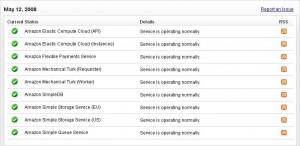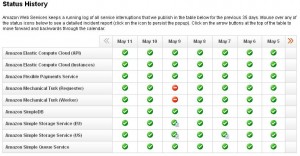
According to the StatCounter blog (more here) there are some problems in the PayPal kingdom. It seems that following an update on PayPal’s web site few issues where reported with the service (confirmed by PayPal and some reported to be solved). However, StatCounter claim that more issues arose:
- The Paypal Handling Cart feature completely broke down
- Cross border payments could not be made as the drop down country list did not work
- Customers have been flooded with hundreds of duplicate subscription emails from Paypal
- Payments from Paypal are no longer associated with the relevant subscriptions
- Some customers have been and are being DOUBLE BILLED by Paypal
- Merchants have not been receiving instant payment notifications or failure notifications
- Merchants/customers are unable to cancel subscriptions

But the main concern was, in StatCounter opinion, is that PayPal did not acknowledge or offer any assistance. They could not get a response fro PayPal via email, phone or any other means of communication. They added that many StatCounter customers did not receive their invoices and some might have been double billed.
I have been using PayPal for some years now and never had any issues with them. If what StatCounter claim is true I see this issue with great concern. the worst thing a company could do is leave their customers in dark and not supply any information and updates.
As you may know WordPress-MU doe’s not allow the users to use all html tags within their posts and pages. This is to reduce the security risks of allowing running scripts and embeddings unfiltered elements. This is done to all level of users even the systems administrators. However, in some cases, one wants to grant the capability of using unfiltered html tags to system admins or other trusted users. This could be archived by using the Unfiltered MU plugin by Automattic:
Unfiltered MU gives Administrators and Editors the unfiltered_html capability. This prevents WordPress MU from stripping <iframe>, <embed>, etc. from these users’ posts.
The plugin can either be used globally for your entire MU site, or it can be applied on a blog-by-blog basis.
For WordPress MU only. Regular WordPress already offers this feature and does not need this plugin.
If you want to allow unfiltered html to all users (NOT RECOMMENDED) drop the plugin in the mu-plugins directory. To allow it just for certain blogs place the plugin in the plugins directory and enable it on per-blog basis.
Just came accross a new plugin by Zong that allows bloggers to charge readers for post, feed or services via SMS:
Content Pay by Zong allows you to monetize your blog content using Premium text messaging. Your reader sends a text message using his mobile phone and he receives a code that gives him access to your content for a determined duration.
Here is the clickable image that appear for paid content:

and the window’s information which tell the user how to pay and get access to the content:

WordPress Mu 1.5.1 is out. Donncha announced:
The long delayed version 1.5.1 of WordPress MU has just been released. If you don’t want to read the rest of this post head to the download page and grab the zip file or tarball but make sure you come back here to read the upgrade docs.
This release of the popular multi-blog version of WordPress is synced with WordPress 2.5.1 and so has all the great features as well as bug and security fixes that went into that release.
Please upgrade!
In my previous post about the first month data of using Amazon’s S3 I had a comment asking about any down time in the service. Well, I have not noticed any down time but I would like to point you to amazon’s current status page. It reads:
Amazon Web Services publishes our most up-to-the-minute information on service availability in the table below. Check back here any time to get current status information, or subscribe to an RSS feed to be notified of interruptions to each individual service. If you are experiencing a real-time, operational issue with one of our services that is not described below, please inform us by clicking on the “Report an Issue” link to submit a service issue report.
With this page you can check the status of each service, report an issue and also sign for an RSS feed for the different services.
 
History data for each service is also available:

Â
April was our first month of using the themes-s3 plugin for offloading WordPress-Mu theme files to Amazon-S3. I have received the monthly bill from Amazon just a few days ago and thought I would share the numbers. So here you go ( the numbers in bold are the real costs):
$0.15 per GB-Month of storage used 0.006 GB-Mo $0.01
$0.10 per GB – all data transfer in 0.011 GB $0.01
$0.18 per GB – first 10 TB / month data transfer out 2.784 GB $0.50
$0.01 per 1,000 PUT or LIST requests 3810 Requests $0.04
$0.01 per 10,000 GET and all other requests 2394466 Requests $2.39
The total monthly cost is $2.95 and most of the charge is for GET requests – 2,394,466 of them. As you can se, storage and data are very cheap and according to Amazon’s announcement, this month they will be even cheaper.
Overall performance has improved but offloading is not the only reason. We did a few more thing with our system but “saving” 2,394,466 requests and file servings must have helped.
I saw a few people looking for solutions to off-load wpmu files to Amazon-S3 service. This is something we wanted to try on our installation (just a few thousand blogs) so I wrote a plugin that will serve themes css and image files from S3.
The plugin uses the ‘stylesheet_directory_uri‘ filter to set the stylesheet uri (css file). In turn, the stylesheet uses the ‘url‘ method to call the image files of the theme so they get the same base url as the stylesheet. Most themes uses the ‘stylesheet_directory‘ call correctly so you will not run into trouble but if a theme uses it to call a php file you should change the call to use ‘template_directory‘.
Download: themes-s3.zip
Usage:
- Signup for an Amazon-S3 account.
- Create a bucket for your files. Since you have to select a globally unique name for your buckets I call it s3.domain.com were domain.com is my wpmu installation.
- To point s3 to your bucket setup a CNAME record: s3 -> s3.domain.com.s3.amazonaws.com. (don’t forget that extra dot at the end).
- Load your themes css and image files to your bucket keeping the exact directory structure for each theme (/wp-contents/themes/… ). You can use the excellent S3 FireFox Organizer to mange your files.
- Edit the plugin to include your bucket name.
- Place the plugin in the mu-plugins directory.
- Test, test and test all your themes!
Whats next? The next step I’m planning is to off-load the Java Scripts in the wp-includes folder. Also planned is an option to serve the users files from S3. If you are interested in helping in any way please leave a comment and we can take it from there.
As I promised a few days ago, the 5 minutes video plugin is now ready. What is 5min:
5min is a place to find short video solutions for practical questions and a place for people to share their knowledge.
The idea behind 5min is very simple: any solution can be visually explained in no more than 5 minutes. Our goal is to create the first communal Life Videopedia allowing users from all over the globe to contribute their knowledge by sharing visual guides in areas such as arts, business, fashion, sports, health, tech, food, and much more.
Download: 5min-video.zip
Install: For WordPress-MU just place in the mu-plugins directory. For the personal version of WordPress drop the file in the plugins directory and activate it.
Usage: each 5min video has a special unique id. It is the number at the end of the viseo’s URL. Just copy the number of the video you want to embed and place it like shown in the followin example:
[5min:123]
If you face any problems please leave a comment below.
![]()




